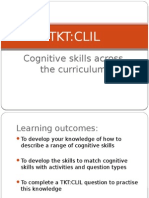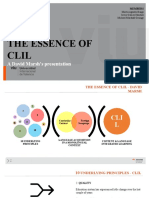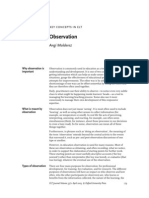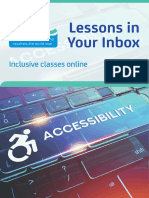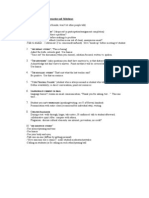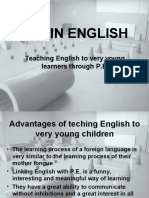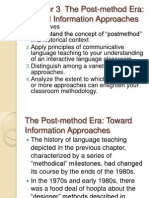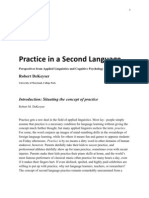CLIL Inspired 1 Unit 3 Science TN PDF
CLIL Inspired 1 Unit 3 Science TN PDF
Uploaded by
OSRAMACopyright:
Available Formats
CLIL Inspired 1 Unit 3 Science TN PDF
CLIL Inspired 1 Unit 3 Science TN PDF
Uploaded by
OSRAMAOriginal Title
Copyright
Available Formats
Share this document
Did you find this document useful?
Is this content inappropriate?
Copyright:
Available Formats
CLIL Inspired 1 Unit 3 Science TN PDF
CLIL Inspired 1 Unit 3 Science TN PDF
Uploaded by
OSRAMACopyright:
Available Formats
3
INSPIRED 1
CLIL Science Webquest
Teachers Notes
You are what you eat
Aims
To learn about balanced diets and food groups.
Activities
Discussing healthy habits; reading about the five food groups; deducing vocabulary from clues; representing
information in the form of a chart; reading comprehension through true/false activities; collecting data in a
food journal.
Language
Adverbs of frequency; simple present for habits; the verb to be; imperatives; vocabulary relating to food and nutrition
To use
After Unit 3, either in class or as homework.
Useful
information
Research has shown that children and teenagers need to maintain a healthy, balanced diet. In general terms, a balanced
diet is rich in fruits, vegetables, and grains. It also contains moderate amounts of protein, milk, and other dairy products.
Procedure
This CLIL worksheet can be given as homework or be done in class. For each activity, students can either check
answers in pairs and then with the whole class, or use the Macmillan Online Dictionary to help with vocabulary if
they are working at home: www.macmillandictionary.com
As a warmer, dictate ten food words or show images of ten different food items and ask students to categorize them as
healthy or unhealthy.
Ask students to read the sentences in exercise 1 and check the correct column for them. Ask volunteers to share their
answers with the class (if they feel comfortable doing so) and discuss if their eating habits are healthy.
Next, ask students to name the foods they can see in the pictures (meat and eggs, bread, vegetables, dairy products,
chocolate).
Ask students to read the text in exercise 2 and decide if they have a balanced diet. When they have finished, ask some
comprehension questions: How many food groups are there? What are they? Why is junk food and fast food unhealthy?
Remind students to be aware of their food allergies and medical conditions when planning a balanced diet, and to
seek professional advice about nutrition if necessary.
Ask students to do the crossword puzzle in exercise 3 and find the missing word.
Ask the students to use the information they find online to complete the plate in exercise 4. They should label the
sections with the five food groups from exercise 2.
Ask the students to answer the questions in exercise 5. They can use the websites to help them if necessary.
Ask the students to search for information about healthy diets online and to decide if the dos and donts in exercise
6 are true or false.
The project stage can be set as homework. Students write a journal of what they eat over the course of three days.
Based on this information, they write sentences about their habits, and then compare their results with a classmate.
They should make suggestions on how to be healthier.
Optional activity: Students work in pairs or groups of three. Tell students to race to write down four fruits. The first
group to finish wins a point. Continue with other categories, e.g. four vegetables, food things in the meat food group.
Key
Exercise 3
1
2
M E
E
4
A M
6
7
U M
Exercise 4
Exercise 6
The sections should be labelled in this order
(largest to smallest):
Fruits and vegetables
Grains
Dairy
Meat, fish, and eggs
Oils and sugars.
1T
2F
3T
4F
5F
6T
7F
8F
Exercise 5
1 Fruits and vegetables/Grains
2 Oils and sugars
3 Students own answers.
This page has been downloaded from www.macmillanenglish.com/inspiration
Macmillan Publishers Limited 2012. This sheet may be photocopied and used within the class.
You might also like
- Multiple Intelligences in The Classroom Article by Jennifer NolenDocument3 pagesMultiple Intelligences in The Classroom Article by Jennifer Nolenapi-533624966No ratings yet
- TBL Vs PBLDocument6 pagesTBL Vs PBLMichelleFunesNo ratings yet
- Would You RatvbcbherDocument9 pagesWould You RatvbcbherNicholas CollinsNo ratings yet
- Emotion in Education - ScienceDirectDocument2 pagesEmotion in Education - ScienceDirectMd HanafiahNo ratings yet
- Inspiration CLIL 1 ScienceDocument2 pagesInspiration CLIL 1 ScienceFlorencia LanattiNo ratings yet
- Using Peer Feedback in The Writing Class: Paul RollinsonDocument8 pagesUsing Peer Feedback in The Writing Class: Paul RollinsonSepta Ayu Prawita SariNo ratings yet
- Assessing SpeakingDocument4 pagesAssessing SpeakingLightman_2004No ratings yet
- Kingore Chapter 6 PresentationDocument10 pagesKingore Chapter 6 Presentationapi-338146197No ratings yet
- JACKSON. Providing - New - Access - To - The - General - CurriculumDocument19 pagesJACKSON. Providing - New - Access - To - The - General - CurriculumRaNeMaCa100% (1)
- How To Deal With A Mixed Ability Class PDFDocument24 pagesHow To Deal With A Mixed Ability Class PDFMonMa100% (1)
- CLIL COGNITIVE SKILLS Student SlidesDocument22 pagesCLIL COGNITIVE SKILLS Student SlidesmelotooleNo ratings yet
- FP009 Trabajo CO Eng - v1r0Document10 pagesFP009 Trabajo CO Eng - v1r0Giselle Spadoni Teixeira100% (1)
- Natriello 1987Document22 pagesNatriello 1987Paddy Nji KilyNo ratings yet
- Techniques For Teaching Adolescent LearnersDocument9 pagesTechniques For Teaching Adolescent LearnersMartin SketchleyNo ratings yet
- Supervisor Manual 3Document48 pagesSupervisor Manual 3infinity focusNo ratings yet
- Seminar 1 - CLILDocument9 pagesSeminar 1 - CLILJGS1988No ratings yet
- Key Concepts Observation (Malderez 2003)Document3 pagesKey Concepts Observation (Malderez 2003)BritishCouncilAlgeriaNo ratings yet
- Assessment of Young Learners PDFDocument7 pagesAssessment of Young Learners PDFcalookaNo ratings yet
- Effective Strategies For Teaching Vocabulary To Young LearnersDocument12 pagesEffective Strategies For Teaching Vocabulary To Young LearnersFlorin JichiNo ratings yet
- (2005) What Do We Want EAP Teaching Materials ForDocument13 pages(2005) What Do We Want EAP Teaching Materials ForMack MickNo ratings yet
- Classroom Strategies For English Medium Teaching and LearningDocument56 pagesClassroom Strategies For English Medium Teaching and Learningsamanik swiftNo ratings yet
- Vn130 017 Lewington Delta3 Yl 06-2013 SampleDocument28 pagesVn130 017 Lewington Delta3 Yl 06-2013 SampleMaysa Hamdy NadaNo ratings yet
- Language Assessment Literacy PDFDocument16 pagesLanguage Assessment Literacy PDFYoshua YanottamaNo ratings yet
- Read This Insightful Write Up On Dweck's Theory of Motivation by Geoff PettyDocument5 pagesRead This Insightful Write Up On Dweck's Theory of Motivation by Geoff PettyRanjani M RNo ratings yet
- Lessons in Your Inbox 3 InclusivityDocument30 pagesLessons in Your Inbox 3 InclusivityTeresa GalletteNo ratings yet
- "Top Tips For Young Learner Teachers": Teacher Training SlidesDocument81 pages"Top Tips For Young Learner Teachers": Teacher Training SlidesMartin Sketchley100% (3)
- Effective Teaching Around The World: Ridwan Maulana Michelle Helms-Lorenz Robert M. Klassen EditorsDocument793 pagesEffective Teaching Around The World: Ridwan Maulana Michelle Helms-Lorenz Robert M. Klassen Editorszgr2yhf7wpNo ratings yet
- My Teaching PhilosophyDocument4 pagesMy Teaching Philosophyapi-285249417No ratings yet
- Sequencing Tasks: ATESL Adult ESL Curriculum FrameworkDocument34 pagesSequencing Tasks: ATESL Adult ESL Curriculum FrameworkSu Handoko100% (1)
- (Cambridge Language Education) Jack C. Richards, Thomas S. C. Farrell - Professional Development For Language Teachers - Strategies For Teacher Learning (2005, Cambridge University Press)Document7 pages(Cambridge Language Education) Jack C. Richards, Thomas S. C. Farrell - Professional Development For Language Teachers - Strategies For Teacher Learning (2005, Cambridge University Press)Vo Thanh NguyenNo ratings yet
- TKT Module 1: Presentation Techniques and Introductory Activities - Teacher's NotesDocument8 pagesTKT Module 1: Presentation Techniques and Introductory Activities - Teacher's NotesokkaNo ratings yet
- Dictating or Facilitating: The Supervisory Process For Language TeachersDocument16 pagesDictating or Facilitating: The Supervisory Process For Language TeachersLemlem BardoquilloNo ratings yet
- Teaching Writing Teachers About AssessmentDocument16 pagesTeaching Writing Teachers About Assessmentjfiteni4799100% (1)
- Teaching in Multilingual N Multicultural ClassroomsDocument3 pagesTeaching in Multilingual N Multicultural ClassroomsBaby PandaNo ratings yet
- Game Based Learning in ESLDocument86 pagesGame Based Learning in ESLWandi huang100% (1)
- Gulbahar H. Beckett - A Paradigm Shift For Language Education Project-Based Learning and Teaching (Routledge Research in Language Education) - Routledge (2024)Document167 pagesGulbahar H. Beckett - A Paradigm Shift For Language Education Project-Based Learning and Teaching (Routledge Research in Language Education) - Routledge (2024)MJMorkNo ratings yet
- Learner Autonomy and Learner TrainingDocument5 pagesLearner Autonomy and Learner TrainingGeethanjali Anbalagan100% (1)
- Developing Speaking Skill Through Task-Based MaterialsDocument6 pagesDeveloping Speaking Skill Through Task-Based MaterialsWendy FernandoNo ratings yet
- The Rules of Elearning Engagement:: A Formula For SuccessDocument50 pagesThe Rules of Elearning Engagement:: A Formula For SuccessAnonymous EaHxdJwNo ratings yet
- Shohamy 2001 Testing PDFDocument19 pagesShohamy 2001 Testing PDFAnindita PalNo ratings yet
- Mar Apr 2019Document32 pagesMar Apr 2019KalyanNo ratings yet
- Forum OkDocument7 pagesForum OkAnonymous hgtHmwNo ratings yet
- ELTM Assignment - IDocument3 pagesELTM Assignment - Iheshanu shlNo ratings yet
- Whatsapp in TeachingDocument38 pagesWhatsapp in TeachingTaris TallasaNo ratings yet
- Learning ContinuumDocument2 pagesLearning ContinuumcorinaNo ratings yet
- Class Management Tips ScenariosDocument3 pagesClass Management Tips ScenariosRia Galo ItGirl100% (1)
- Creative Practice GrammarDocument71 pagesCreative Practice GrammarLeslie HutchinsonNo ratings yet
- Teaching English To Very Young LearnersDocument10 pagesTeaching English To Very Young LearnersceipangelsNo ratings yet
- Storytelling To Enhance Speaking and Listening Skills For English Young Learners: A Case Study at Language Centers in Binh Duong ProvinceDocument8 pagesStorytelling To Enhance Speaking and Listening Skills For English Young Learners: A Case Study at Language Centers in Binh Duong ProvinceHai Hau Tran100% (1)
- SLA 4, L1 and L2 LearningDocument19 pagesSLA 4, L1 and L2 LearningNenden Sri FujiyaNo ratings yet
- Day 1 Hawaii Lesson PlanDocument2 pagesDay 1 Hawaii Lesson Planapi-686726808No ratings yet
- Exploring Vocabulary Learning Strategies in A Second Language Setting A ReviewDocument13 pagesExploring Vocabulary Learning Strategies in A Second Language Setting A ReviewАдилет СаматовNo ratings yet
- Extensive Reading - Why Aren't We All Doing ItDocument9 pagesExtensive Reading - Why Aren't We All Doing ItRODRIGO ANDRÉS ARIAS ZAMORANo ratings yet
- Teaching by Principle - Chapter 3Document128 pagesTeaching by Principle - Chapter 3Abdul Khalik Assufi100% (2)
- Learners' Technology Integration in English Language LearningDocument11 pagesLearners' Technology Integration in English Language LearningPsychology and Education: A Multidisciplinary JournalNo ratings yet
- Differentiated Instruction in The Foreign Language Classroom PDFDocument8 pagesDifferentiated Instruction in The Foreign Language Classroom PDFnengcintiaNo ratings yet
- Practice in A Second LanguageDocument12 pagesPractice in A Second Languagehredmbngysff100% (1)
- Language Teacher Recognition: Narratives of Filipino English Teachers in JapanFrom EverandLanguage Teacher Recognition: Narratives of Filipino English Teachers in JapanNo ratings yet
- Vocabulary-EXTRA Inspired 1 Units 7-8 Extension PDFDocument1 pageVocabulary-EXTRA Inspired 1 Units 7-8 Extension PDFOSRAMANo ratings yet
- Vocabulary-EXTRA Inspired 1 Units 3-4 Consolidation PDFDocument1 pageVocabulary-EXTRA Inspired 1 Units 3-4 Consolidation PDFOSRAMANo ratings yet
- Vocabulary-EXTRA Inspired 1 Units 7-8 Consolidation PDFDocument1 pageVocabulary-EXTRA Inspired 1 Units 7-8 Consolidation PDFOSRAMANo ratings yet
- Inspired Level 1 Guided Writing - Units3 4 TN PDFDocument1 pageInspired Level 1 Guided Writing - Units3 4 TN PDFOSRAMANo ratings yet
- Vocabulary EXTRA!: Unit 3 Unit 4Document1 pageVocabulary EXTRA!: Unit 3 Unit 4OSRAMANo ratings yet
- Vocabulary-EXTRA Inspired 1 Units 1-2 Extension PDFDocument1 pageVocabulary-EXTRA Inspired 1 Units 1-2 Extension PDFOSRAMANo ratings yet
- Vocabulary-EXTRA Inspired 1 Extension Answers PDFDocument1 pageVocabulary-EXTRA Inspired 1 Extension Answers PDFOSRAMANo ratings yet
- Grammar-EXTRA Inspired 1 Unit 8 Countable Uncountable Nouns PDFDocument1 pageGrammar-EXTRA Inspired 1 Unit 8 Countable Uncountable Nouns PDFOSRAMANo ratings yet
- Grammar-EXTRA Inspired 1 Unit 7 Verb Gerund PDFDocument1 pageGrammar-EXTRA Inspired 1 Unit 7 Verb Gerund PDFOSRAMANo ratings yet
- Grammar EXTRA!: Tag Questions With BeDocument1 pageGrammar EXTRA!: Tag Questions With BeOSRAMANo ratings yet
- Grammar-EXTRA Inspired 1 Unit 5 Comparatives PDFDocument1 pageGrammar-EXTRA Inspired 1 Unit 5 Comparatives PDFOSRAMA0% (1)
- Grammar-EXTRA Inspired 1 Unit 5 Simple Present or Present Progressive PDFDocument1 pageGrammar-EXTRA Inspired 1 Unit 5 Simple Present or Present Progressive PDFOSRAMANo ratings yet
- Grammar-EXTRA Inspired 1 Unit 6 Simple Past Be PDFDocument1 pageGrammar-EXTRA Inspired 1 Unit 6 Simple Past Be PDFOSRAMANo ratings yet
- Grammar-EXTRA Inspired 1 Unit 5 Possessives PDFDocument1 pageGrammar-EXTRA Inspired 1 Unit 5 Possessives PDFOSRAMANo ratings yet
- Grammar-EXTRA Inspired 1 Unit 7 Superlative Adjectives PDFDocument1 pageGrammar-EXTRA Inspired 1 Unit 7 Superlative Adjectives PDFOSRAMANo ratings yet
- Grammar-EXTRA Inspired 1 Unit 2 Can and Cant PDFDocument1 pageGrammar-EXTRA Inspired 1 Unit 2 Can and Cant PDFOSRAMANo ratings yet
- Grammar-EXTRA Inspired 1 Unit 4 Present Progressive PDFDocument1 pageGrammar-EXTRA Inspired 1 Unit 4 Present Progressive PDFOSRAMANo ratings yet
- Culture Inspired 1 Social Situations TN PDFDocument2 pagesCulture Inspired 1 Social Situations TN PDFOSRAMANo ratings yet
- Culture Inspired 1 The Olympics PDFDocument2 pagesCulture Inspired 1 The Olympics PDFOSRAMANo ratings yet
- Eating On The Go E-BookDocument46 pagesEating On The Go E-BookvignesNo ratings yet
- Listening Practice 3Document4 pagesListening Practice 3salbina arabiNo ratings yet
- WCR Sensory Lexicon Edition 1.1 2016Document50 pagesWCR Sensory Lexicon Edition 1.1 2016Aditya PradiptaNo ratings yet
- How To Do Banana Milk - Google Search PDFDocument1 pageHow To Do Banana Milk - Google Search PDFyeetyourassouttamawayNo ratings yet
- Food ChartDocument2 pagesFood Chartxeped22607No ratings yet
- Production Systems and Procedures For ContractorsDocument23 pagesProduction Systems and Procedures For ContractorsMica BansilNo ratings yet
- Chicken Kurma: Serves: 4 Cooking Time (Approx.) : 42 Minutes Style: North Indian Non-VegetarianDocument3 pagesChicken Kurma: Serves: 4 Cooking Time (Approx.) : 42 Minutes Style: North Indian Non-VegetarianAdrishyaNo ratings yet
- The Canowindra Phoenix: ComprintingDocument4 pagesThe Canowindra Phoenix: ComprintingCanowindra PhoenixNo ratings yet
- Could/ Can You ? Requests: Grammar WorksheetDocument4 pagesCould/ Can You ? Requests: Grammar WorksheetFREDY LEONARDO QUESQUEN MILLONES100% (1)
- Pixelsutra Dairy Industry Market Analysis & StrategiesDocument19 pagesPixelsutra Dairy Industry Market Analysis & StrategiesjackNo ratings yet
- Velkommen Til Bords IngredientsDocument3 pagesVelkommen Til Bords Ingredientsapi-77502851No ratings yet
- Food Culture in Tamil Nadu - A Study Indian Cuisine CurryDocument1 pageFood Culture in Tamil Nadu - A Study Indian Cuisine CurryPiyush SharmaNo ratings yet
- English Language Written Exercise - Year 5Document4 pagesEnglish Language Written Exercise - Year 5Suzanawati OmarNo ratings yet
- Malaysia Food RegulationDocument168 pagesMalaysia Food RegulationBoh TuansimNo ratings yet
- TLE-Cookery-NCII Grade10 QTR1 Module-6Document17 pagesTLE-Cookery-NCII Grade10 QTR1 Module-6Jasmine Pearl WongNo ratings yet
- Siargao Tour PackageDocument3 pagesSiargao Tour PackageXandara YannNo ratings yet
- Business PlanDocument6 pagesBusiness PlanChristel Anne B. NepomocenoNo ratings yet
- Quantifiers in EnglishDocument6 pagesQuantifiers in EnglishVinicius SoaresNo ratings yet
- Sample Abstract - Executive Summary & Product Description - Booster JuiceDocument2 pagesSample Abstract - Executive Summary & Product Description - Booster Juiceakshita ramdasNo ratings yet
- Establishment and Management of Desmodium Ovalifolium S PasturesDocument2 pagesEstablishment and Management of Desmodium Ovalifolium S PasturesNewton de Lucena Costa100% (1)
- Soal PTS KLS 9 B.inggrisDocument6 pagesSoal PTS KLS 9 B.inggrisDeti Kurnia DewiNo ratings yet
- No-Fail Gluten-Free Bread BakingDocument206 pagesNo-Fail Gluten-Free Bread BakingCarol100% (8)
- Childhood Hunger Lit ReviewDocument9 pagesChildhood Hunger Lit Reviewapi-240973744No ratings yet
- Menu Reservasi Reguler OBELIX HILLS-1Document8 pagesMenu Reservasi Reguler OBELIX HILLS-1Hari SaputroNo ratings yet
- 6A Vocab WKSHTDocument1 page6A Vocab WKSHTjorge gil piquerasNo ratings yet
- Lil'Bites - Valrhona ChocolateDocument5 pagesLil'Bites - Valrhona ChocolateRapanakis TasosNo ratings yet
- Procedural Text (KBM Englsih)Document12 pagesProcedural Text (KBM Englsih)jjhjungg jaejaeNo ratings yet
- Me and My Shopping WorksheetsDocument26 pagesMe and My Shopping WorksheetsAVENGERS للمعلوماتيةNo ratings yet
- Unit 4 Corn MillingDocument5 pagesUnit 4 Corn MillingMohit JalandhraNo ratings yet
- Fishball SauceDocument3 pagesFishball SauceGrace Denito RaymundoNo ratings yet










